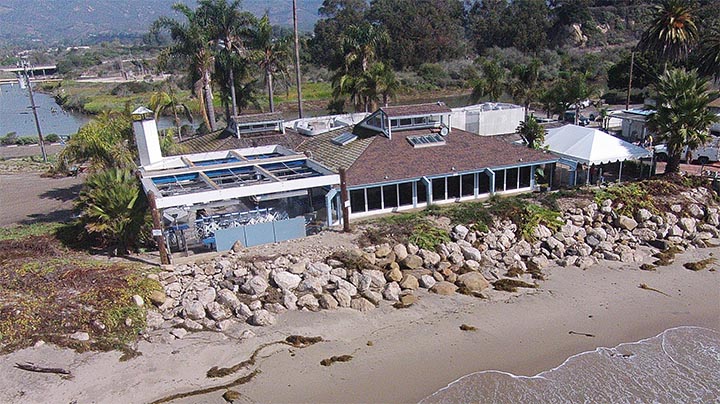
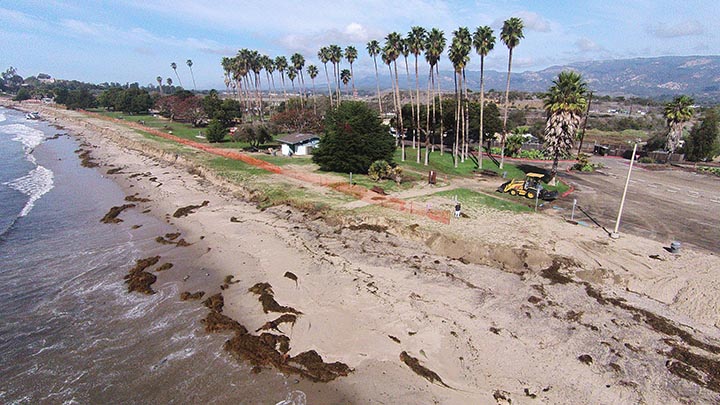
March 3, 2014. Aerial view of Goleta Beach Park and eroded bluff along south edge of park following winter storm waves and high tides in early March, 2014. None of the beach bluff in this view was protected from erosion prior to 2016.
2015-2016-2017 El Niño Erosion at Goleta Beach Park
All images © Arthur Sylvester, 2016, 2017
| Meteorologists predicted winter 2015-2016-2017 would be a time of powerful El Niño storms with associated coastal erosion and damage to shoreline structures. The Beachside Bar-Cafe was viewed as particularly vulnerable, because major storm waves battered the Santa Barbara County coastline on March 1, 2014, breaking windows in the Beachside Bar-Cafe and flooding it with water and sand. |
 |
| March 3, 2014. Aerial view at low tide of Beachside Bar-Cafe following storm wave damage on March 1, 2014. The boulder revetment prevented extreme damage. |
 |
March 3, 2014. Aerial view of Goleta Beach Park and eroded bluff along south edge of park following winter storm waves and high tides in early March, 2014. None of the beach bluff in this view was protected from erosion prior to 2016. |
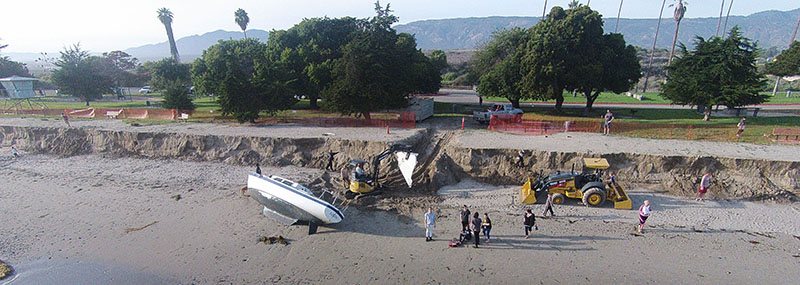 |
| March 14, 2014. Winter storm waves typically carve a steep sandy cliff, like this one, which is not repaired naturally or artificially afterward. Instead, the net effect over time is progressive widening of the beach and loss of park land. |
County officials feared the 2015-2016 El Niño might be at least as powerful and damaging as that in 1983 or 1993, and so it applied to the California Coastal Commission to build a sand berm along 2,400 feet of Goleta Beach County Park and the restaurant. A permit was granted to dredge 80,000 cubic yards of sand from the mouth of Goleta Slough over a three week period from 30 November to 20 December 2015 and emplace that sand in front of the restaurant and along the Goleta Beach Park bluff. |
| December 5, 2015. Sand hauling truck taking sand from the mouth of Goleta Slough (upper) to construct a sand berm in front of the Beachside Bar-Cafe (lower). |
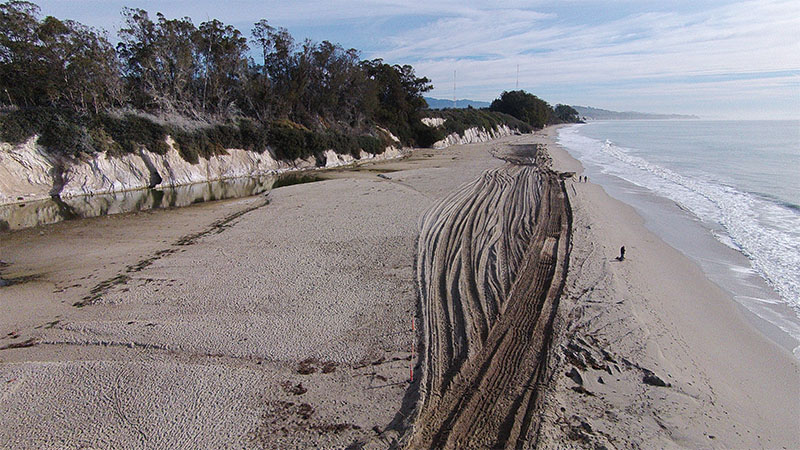 |
| December 5, 2015. Aerial view of sand dredge area at mouth of Goleta Slough. |
| December 11, 2015. Two giant trucks hauled the sand and constructed a formitable berm in front of the restaurant, but during its first week of existence, big sea swells riding in on 7" high tides (above) over several days washed most of the sand back down coast to the slough mouth. Sand dredging, trucking, and construction of the sand berm continued throughout the permit period, but alas, each input of sand was washed away during the next high tide, as is happening in the image below. |
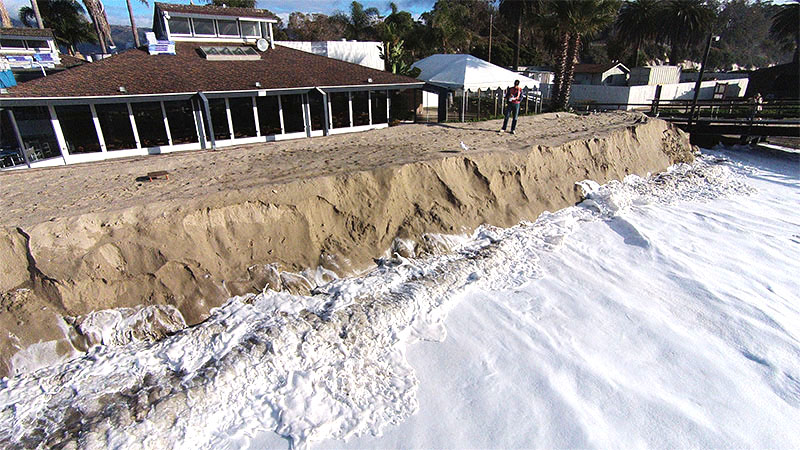 |
| Upon expiration of the dredging permit, the County contracted two earth movers to scoop sand directly from the beach in front of the restaurant and park to replenish the eroded berm. Removal of sand from the beach and piling it up as a berm against the park lowered the berach profile and thus only made it easier for storm waves to reach farther inshore with each high tide, easily washing away the newly emplaced sand (below). |
| January 8, 2016. At the same time the storm waves were gnawing away at the sand berm and the park, both of the 1988 and 1994 rock revetments were battered but holding on and preventing erosion of the parking lot (above) from the point at the west end of the park to the middle of the park (below). Clearly it was unnecessary to cover the revetment with dredged sand, because the rocks did their job as intended, whereas the sand covering was eroded away during each high tide (below). |
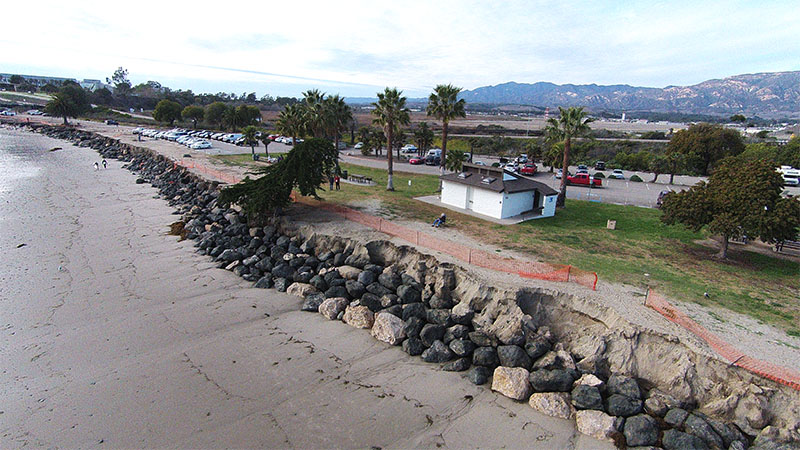 |
| Erosion mitigation came to a head in the first week of March, 2016, when powerful storm swells roared in on six foot high tides for several days, removing all traces of the sand berm in the central section of the park not previously protected by a rock reventment. The 2016 wave erosion particularly exploited old trenches dug into the park in the 1940s for drainage pipes and backfilled with sand and rubble. Initially the waves eroded several 20 foot-long caverns along the old trenches, but eventually the roofs of most of them collapsed, leaving 6 foot-deep ditches engraved into the park and nearly undermining concrete pads for benches and barbeques. |
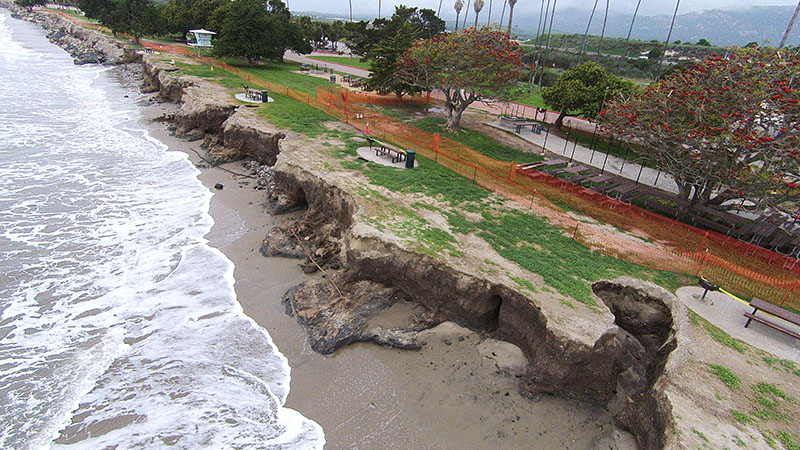 |
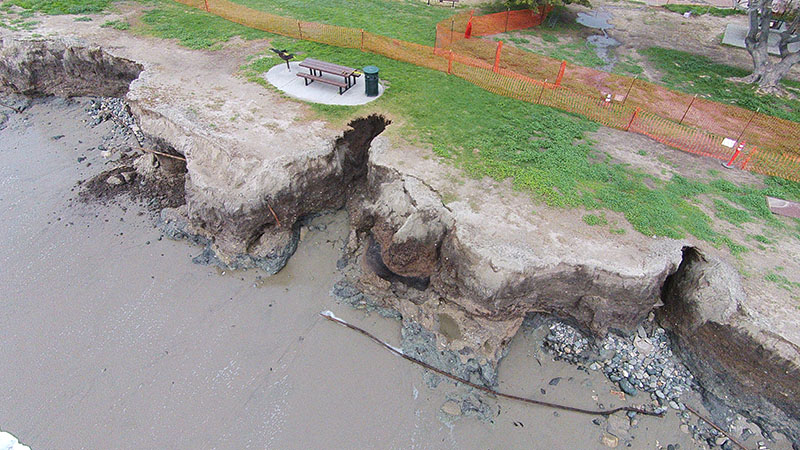 |
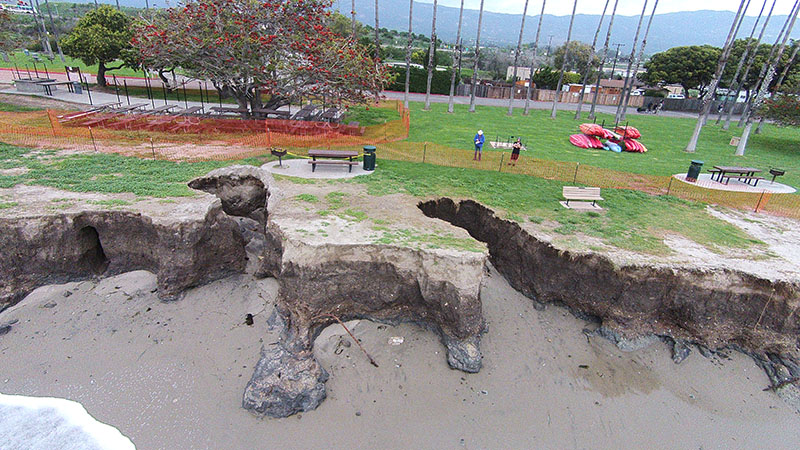 |
The County, realizing that the erosion and ditches constituted safety hazards as well as reducing the area of the park already made substantially small by wave erosion in the 1983 and 1993 El Niños, applied to the California Coastal Commission for an emergency permit to repair the erosion damage and protect the park from further erosion by installation of a geotextile fabrication instead of a rock revetment. The County wasted little time commencing the project once approval was given. Already two weeks after the storm damage in April 2016, a contractor was busy digging away the damaged section of park and installing layers of plastic webbing wrapped around rocks and covering the whole with sand taken again right from the beach. |
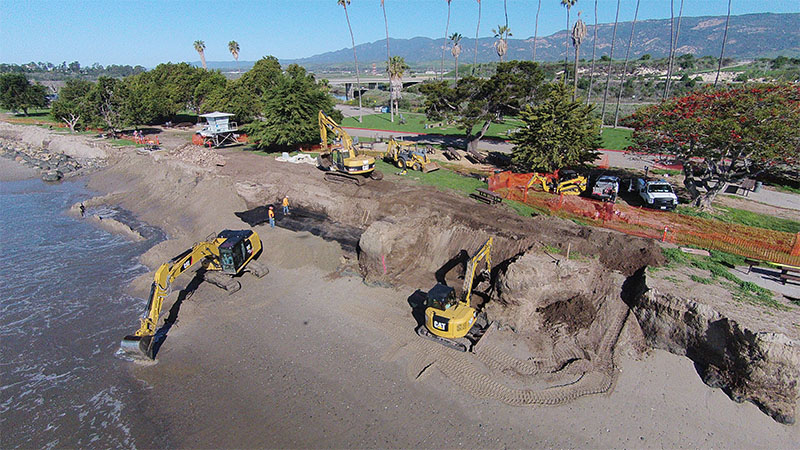 |
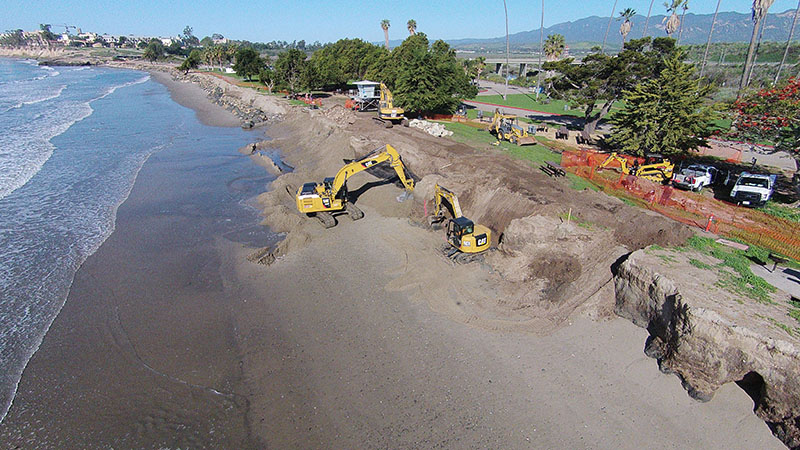 |
 |
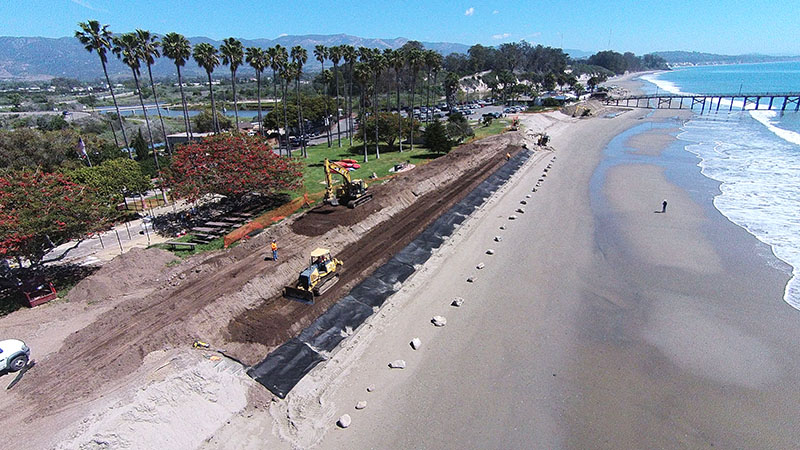 |
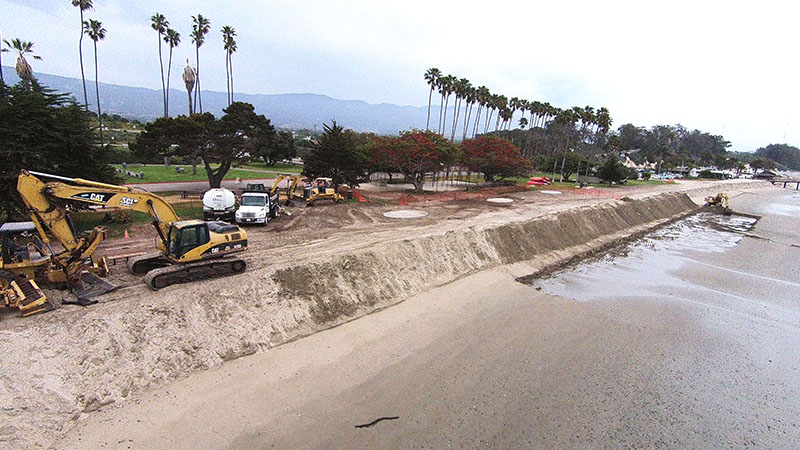 |
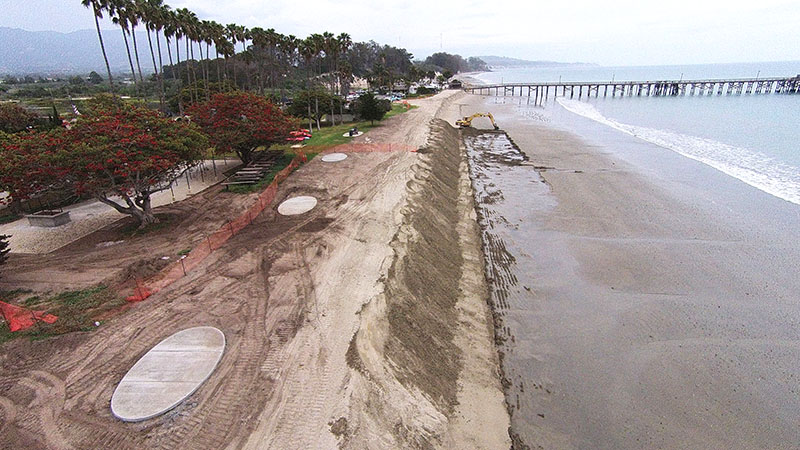 |
The geotextile project was completed in April, 2016, and all was hunky dory until another set of storm waves, not related to any El Niño, rolled in on seven foot high tides in late October and early November 2016. The waves removed the sand covering the geotextile fabrication, but the fabrication itself resisted the erosion just as intended. Eventually the fabrication will have to be recovered with sand, which would be better obtained from a source other than the immediate beach. |
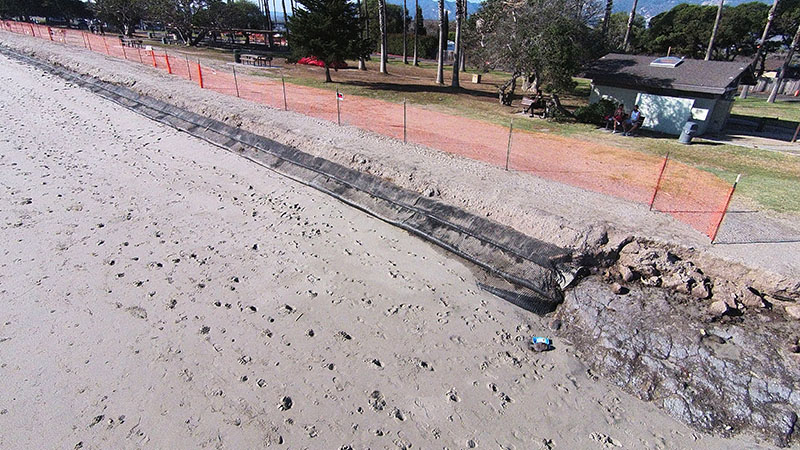 |
 |
The damage in the lower right corner of the two images above occurred where the geotextile was not installed. Then came El Niño storms in February, 2017, however, which destroyed the entire geotextile installation. See below. |
| The geotextile installation was a complete and costly failure. Strong El Niño storms in February 2017 not only tore away the mesh fabric, but also scattered the cobbles that were supposed to hold the mesh in place. Everything was eventually removed and replaced with a rock revetment. |